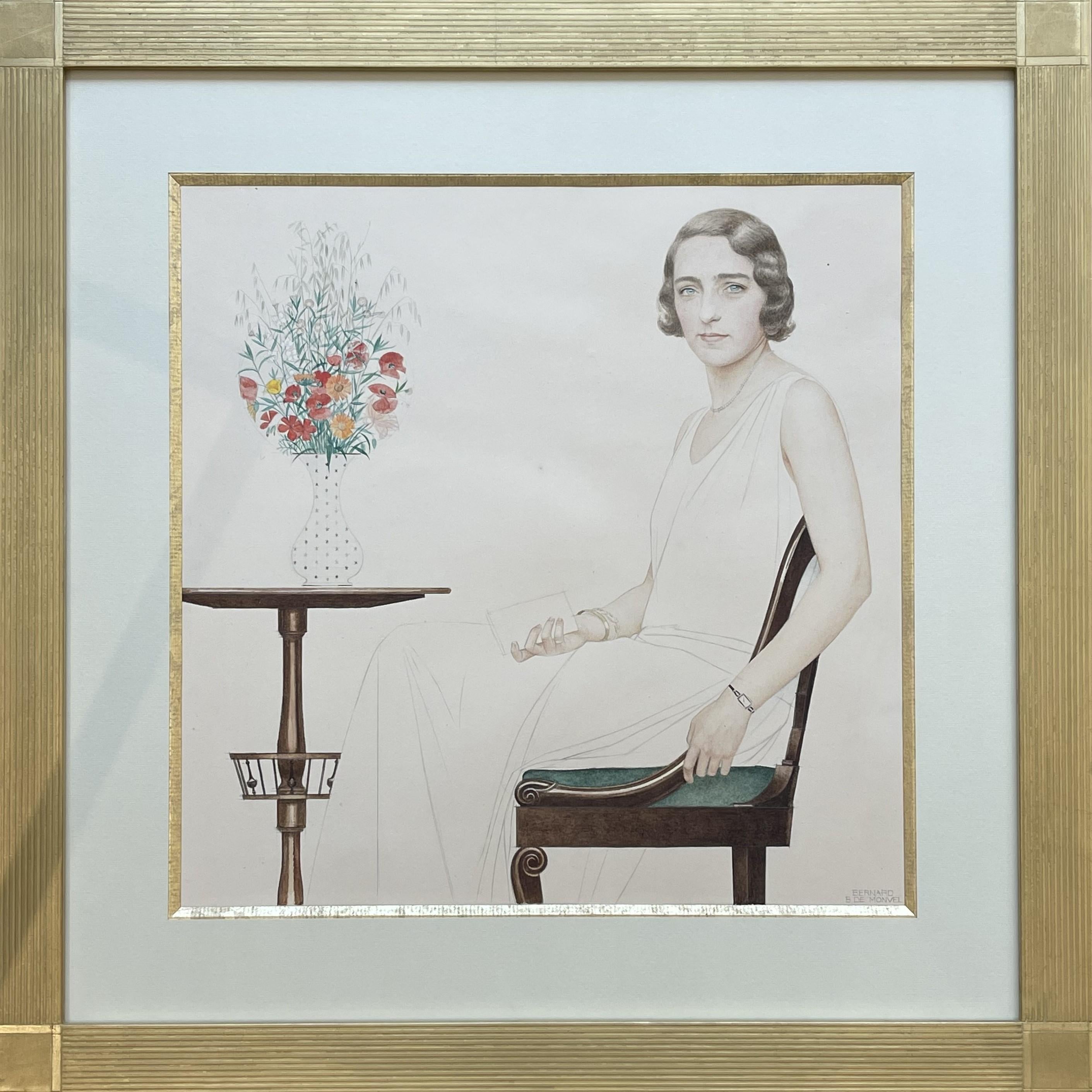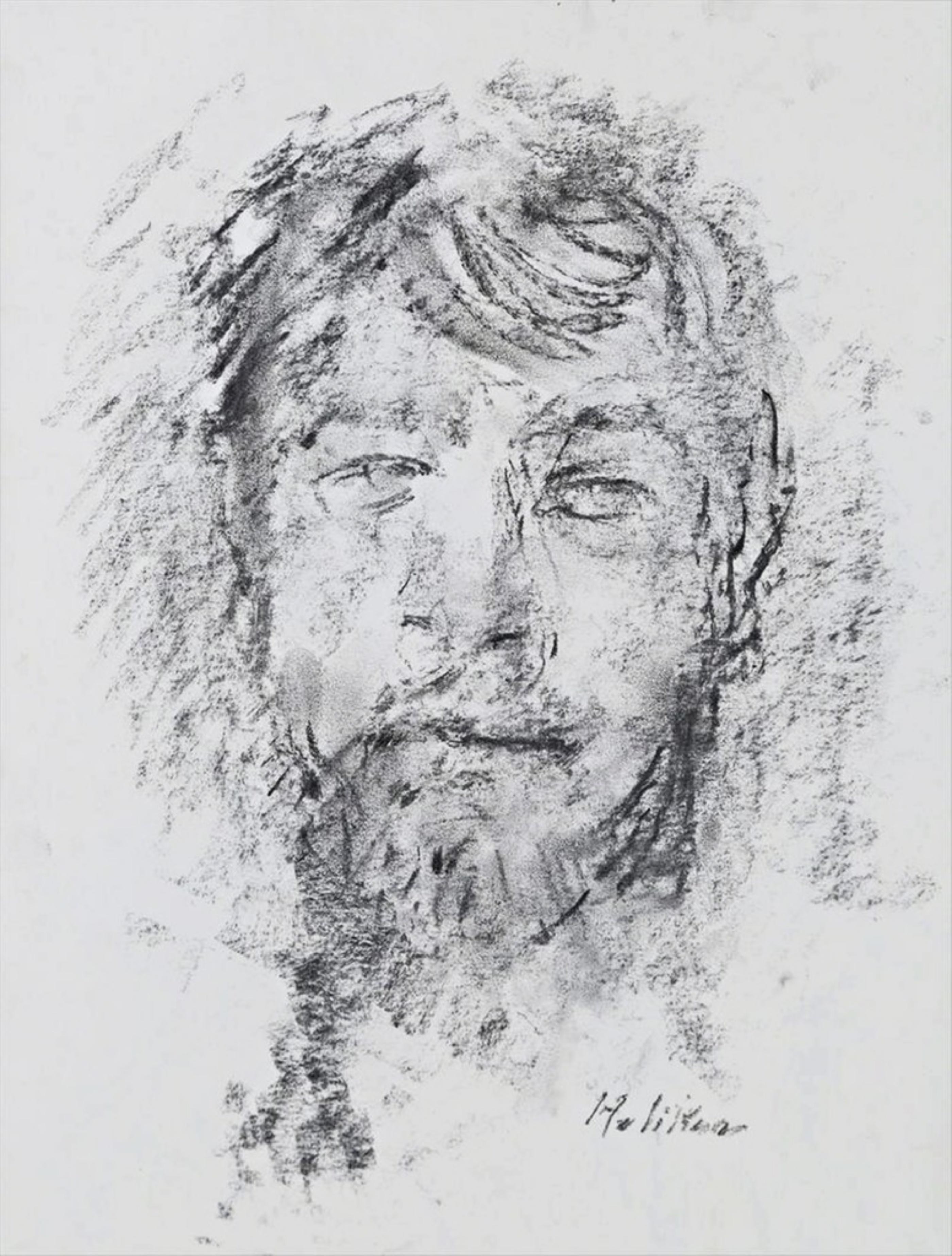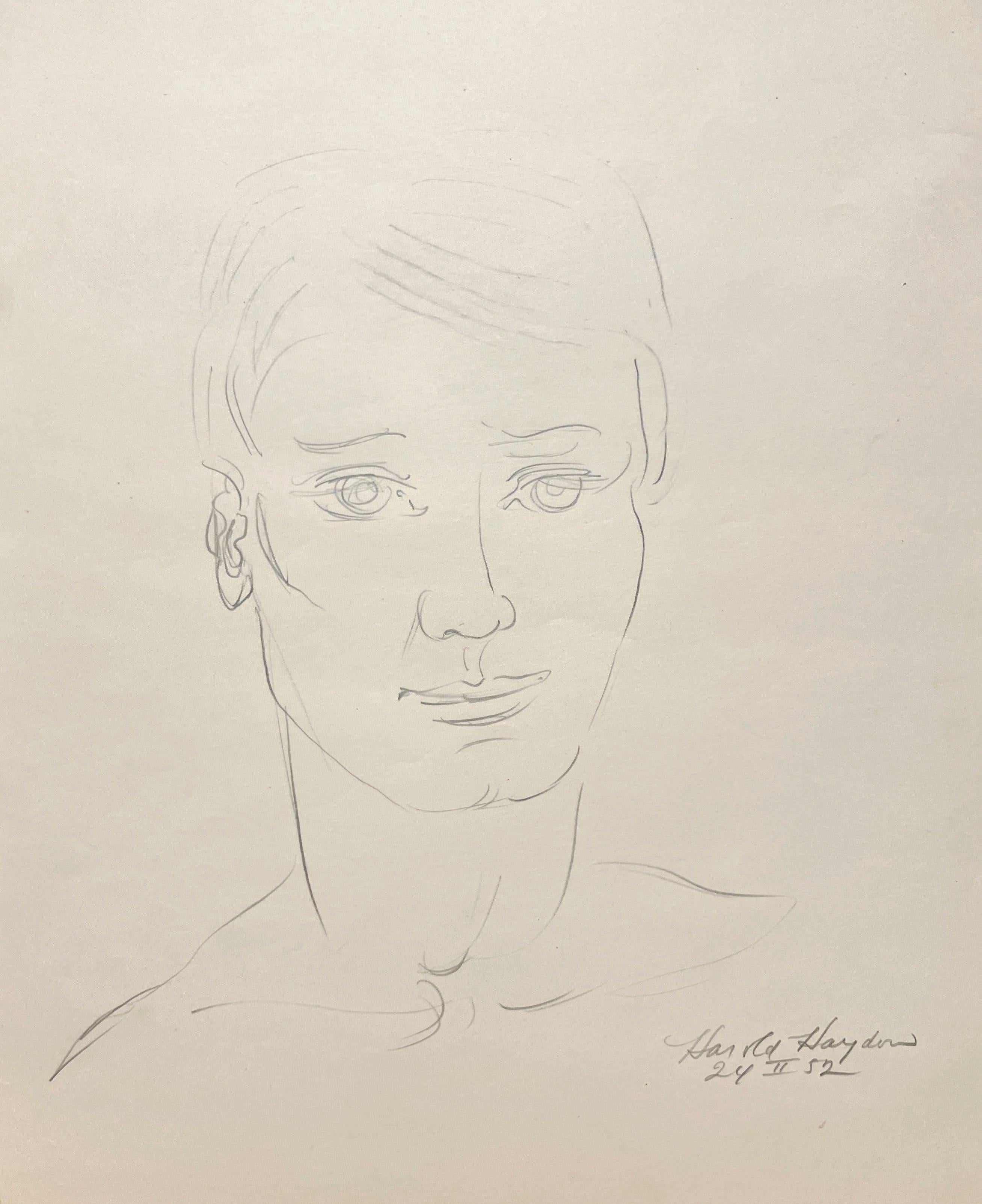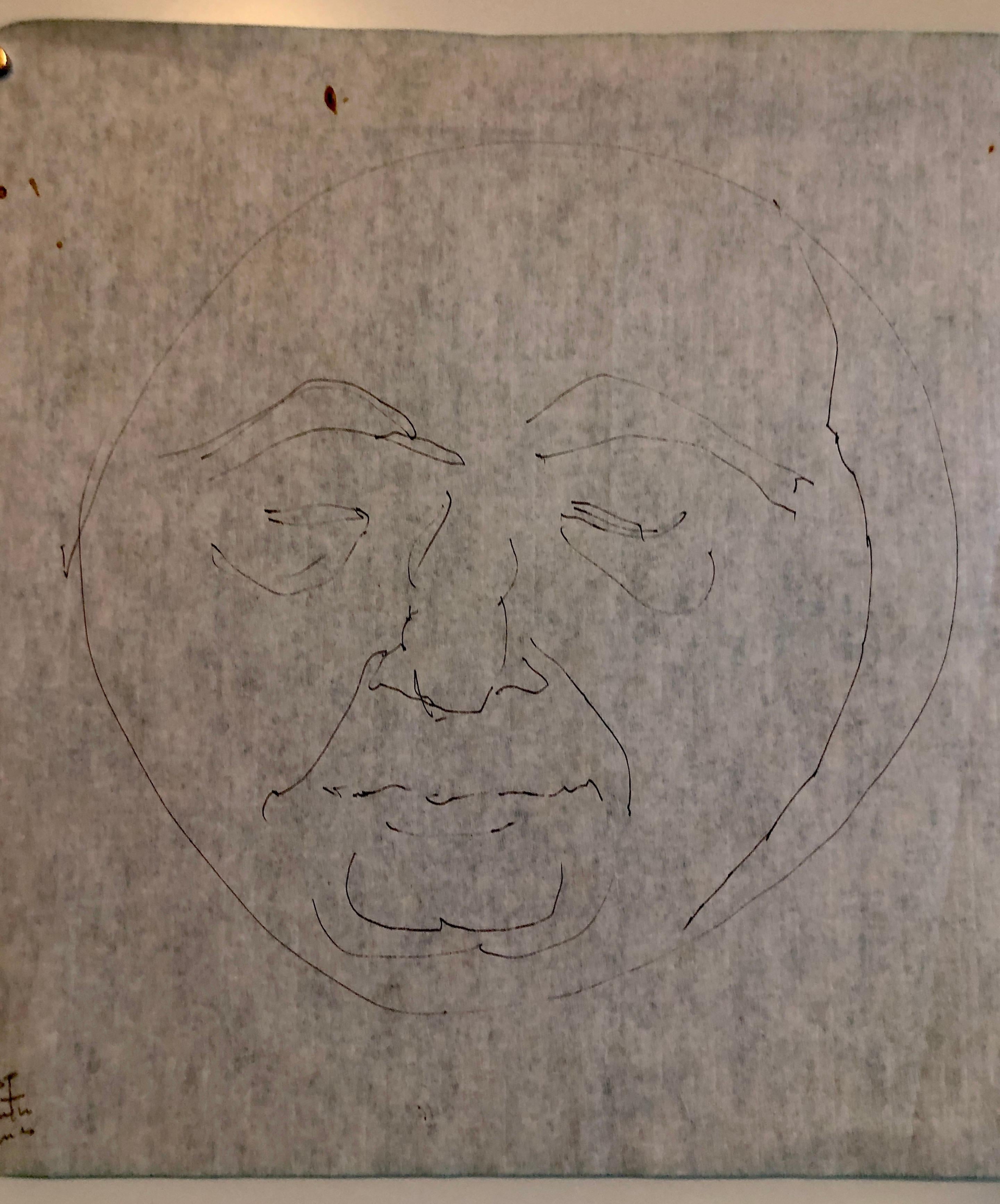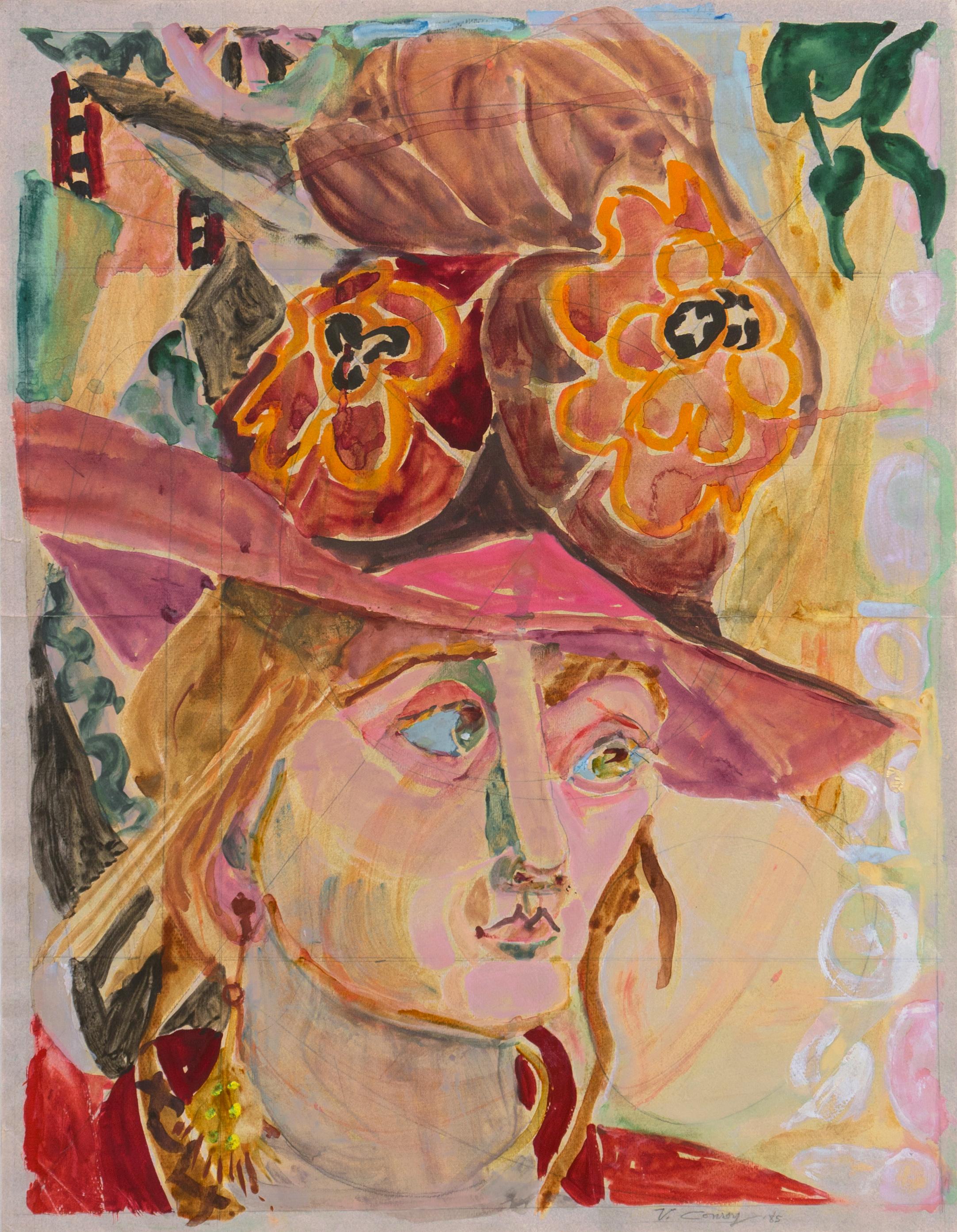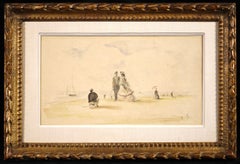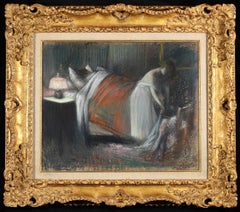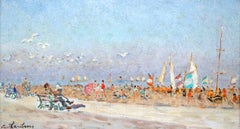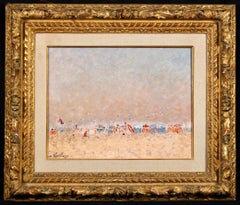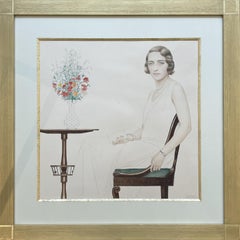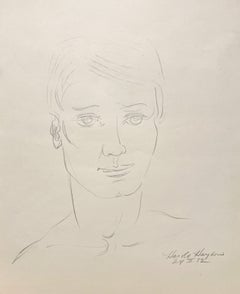Articles similaires à Portrait of Berthe Lipchitz - Modern Portrait Pencil Drawing - Amedeo Modigliani
Vous voulez plus d'images ou de vidéos ?
Demander au vendeur plus d'images ou de vidéos
1 sur 14
Amedeo ModiglianiPortrait of Berthe Lipchitz - Modern Portrait Pencil Drawing - Amedeo Modigliani1916
1916
À propos de cet article
Signed pencil on paper portrait drawing by Italian artist Amedeo Clemente Modigliani. The portrait is of Berthe Lipchitz who was the wife of Modigliani's friend, the sculptor Jacques Lipchitz. This work is a study for "Portrait of Jacques & Berthe Lipchitz" which hangs in the Art Institute of Chicago.
Signature:
Signed lower right
Dimensions:
Framed: 26.75"x18.25"
Unframed: 18.75"x12.25"
Provenance:
The collection of Leopold Survage
The collection of Dimitri Snegaroff
The collection of Leopold Zborowski
Galerie Charpentier - Paris 1958
Private french collection
Galerie Pierre Levy - Paris
Private collection - United Kingdom
Exhibited:
Galerie Charpentier - Cent Tableaux de Modigliani - Paris, 1958
Les Peintres de Zborowski - ~Foundation L'Hermitage, Lausanne 1994
Amedeo Modigliani Exhibition - Museo d'Arte Moderna, Lugano 1999
Amedeo Modigliani was born into a middle-class Jewish family and was the brother of Eugenio Modigliani, who later became the leader of the Italian socialist workers’ party prior to the rise of fascism. Modigliani suffered from poor health as a child and contracted pleurisy in 1895, followed in 1898 by typhus with pulmonary complications, which culminated in tuberculosis in 1901. He moved to Livorno to study under Guglielmo Micheli, who had himself been a pupil of Giovanni Fattori, one of the Macchiaioli group of painters who worked in strong colour patches (macchie) to achieve vivid light and colour effects; their approach came as a reaction against academic art in Italy and, in much the same way as the French Impressionists, they advocated painting from nature rather than aspiring to communicate any particular message or ideology. In 1902, Modigliani enrolled at the academy of fine arts in Florence. He travelled to Rome and Venice in 1903, where he devoted the bulk of his day to visiting museums. At around this time he started to read Dante, dreaming no doubt of the Vita Nuova; he also devoured the works of Leopardi, Carducci, d’Annunzio, Spinoza and Nietzsche.
In 1906, Modigliani moved to Paris, lodging at the Rue Caulaincourt. At that juncture, nothing about him appeared to presage the brilliant career that was to follow. His arrival in the artists’ quarter, then known colloquially as the maquis - the labyrinthine tangle of narrow streets around today’s Avenue Junot in Montmartre - went virtually unnoticed by the artists already living and working there, including Picasso, Braque and Derain. Modigliani’s painting made next to no immediate impact and he was recognised primarily on account of his frail constitution, flashing eyes, innate elegance and intellectual prowess. He was accepted in the community that was Montmartre but never belonged to any particular ‘set’ or circle, and there is no record of his ever having been invited to Pablo Picasso’s studio, the famous ‘wash house’.
The literate and highly articulate Modigliani opted instead for the companionship of Maurice Utrillo, an instinctual painter of whom it could charitably have been said that his conversation was, at best, limited. Nonetheless, Modigliani and ‘Litrillo’ (as Utrillo was commonly known to the street urchins - the ‘p’tits poulbots’) began to frequent the cabarets and dance halls of the Butte de Montmartre, and the nefarious hashish dens - post-Baudelaire ‘institutions’, frequented in the main by out-of-work writers and talentless artists. Modigliani developed an addiction, which, compounded by his alcoholism, took its toll. It also transformed him from an artist of limited ability into one devoid of bourgeois scruples.
In his monograph, Modigliani: Sa Vie et Son Oeuvre, written in 1926 shortly after Modigliani’s death, André Salmon hinted at a ‘pact with the devil’. While somewhat overstating the case, this rather unpromising painter from Livorno metamorphosed virtually overnight into an artist of rare ability and sensitivity. The turning-point came in 1907, when Modigliani met Paul Alexandre, a doctor who befriended him, took him under his wing and purchased some of his work. The banal paintings he had turned out in Montmartre were suddenly superseded by exceptional works, produced first in Montmartre ( Cellist, 1909), and then in Montparnasse.
In Montparnasse, Modigliani started to move in artistic circles, meeting Chaim Soutine, Marc Chagall, Jules Pascin and others, all of whom lived and worked in the building in the Rue Vaugirard known as ‘La Ruche’ (‘the beehive’). Then, in the Cité Falguière, he met the Romanian-born sculptor Constantin Brancusi, who encouraged him to take up sculpture, which he did, between 1909 and 1913. In 1914, several dealers, including the erstwhile poet Léopold Zborowski and the collector Paul Guillaume, tried with little success to market Modigliani’s paintings. From 1914 to 1916, Modigliani was caught up in a tempestuous affair with the English poet and journalist Beatrice Hastings. In 1917, however, he met Jeanne Hébuterne at the Colarossi Academy, who became his constant companion and model, and who gave birth to their daughter Jeanne in 1918. In 1918 and 1919, Modigliani and Jeanne spent time in Nice on the Côte d’Azur but by 1920 he was suffering from tubercular meningitis. His friends, Kisling and the Chilean Ortiz de Zarate, brought him and a pregnant Jeanne back to Paris, where he died on January 20 1920 in the Hôpital de la Charité. His last words were reputed to be: ‘Cara Italia’. Modigliani’s brother, by this time a socialist member of parliament, telegrammed instructions to ‘bury him as befits a prince’. Jeanne Hébuterne, a budding twenty-year-old painter, killed herself and her unborn child on the day of Modigliani’s funeral by jumping to her death from a fifth-floor window.
Modigliani’s first paintings were undistinguished portraits in the Impressionist manner. After moving to Paris in 1907, his early work was influenced by the Swiss-born lithographer Théophile Alexandre Steinlen, Henri de Toulouse-Lautrec and Pablo Picasso, the latter then in his ‘blue’ period. From the onset, Modigliani’s principal preoccupation was the human figure. After the artistic (and literal) limbo of Montmartre, when his output was confined to a few Expressionist-like paintings of street life, the theatre and the circus, Modigliani suddenly erupted on the scene in 1909 with Cellist, a robust, well-constructed and vividly coloured canvas that utterly exceeded all prior expectations. He had not taken part in the protracted debates that took place nightly in Picasso’s studio, but he had superficially assimilated the Cubist ideas developed by Picasso and Georges Braque. Above all, Modigliani had been influenced by African art, which was a key feature of the Cubist movement. He succeeded in treading a fine line between the coolly analytical Cubist approach and the all-too-common European perception of African art as a succession of exaggerated facial grimaces.
It would appear that Modigliani had always been attracted to sculpture as a discipline. The friendly encouragement he received as of 1909 from Brancusi no doubt intensified his interest and reinforced his attempts to achieve a sustained simplicity of line and form. In 1910, he befriended the Russian artists Alexander Archipenko and Jacques Lipchitz, both of whom recorded Modigliani’s distaste for modelling in clay (which he referred to as ‘mud’), on the grounds that it degraded the art of sculpture. Like Brancusi, Modigliani believed in working directly, carving from wood in the case of two extant pieces, and from (sand)stone in others, with the exception of a few bronzes which were, presumably, modelled in clay before being cast into bronze. His sculpture was influenced by archaic and non-western cultures - early Graeco-Roman, African and Khmer - as well as heads carved on columns adorning the façades of Romanesque and Gothic cathedrals (Modigliani rarely sculpted a rear view of his figures). Up to approximately 1912, his sculptures take the form of tall cylinders, usually with elongated heads and shallow relief indentations or projections to indicate the hairline, facial features and neck. He departed from this style only infrequently, most notably in a small number of pieces believed to have been sculpted in 1913, which are characterised by a compressed, cubistic format and shallower and less distinct features. Modigliani eventually abandoned sculpture, presumably because of his general health and circumstances, and possibly due to the fact that his sculptures sold for even less than his paintings. During the years that he devoted to sculpture, Modigliani is recorded as producing only thirty canvases, although after 1913 his sculpture became reflected in his painting.
Following his Montmartre days, Modigliani’s work developed in both quantitative and qualitative terms, presumably helped by the relative stability of his relationship with Jeanne Hébuterne. The first paintings after his short-lived sculptural phase saw him revert briefly to Neo-Impressionist pointillism, followed by a episode marked by Cubism, which was mainly evident in portraits of friends and fellow artists living and working in Montparnasse: Henri Laurens; Juan Gris (1915); Jacques Lipchitz and his Wife; Chaim Soutine; Léopold Sauvage; Paul Guillaume; Max Jacob; Béatrice Hastings con Capello (all 1916); Mlle Modigliani (1917); Léon Bakst; Léopold Zborowski; Concierge’s Son; Adolescent (1918); Mademoiselle Lunia Czechowska; Madame Zborowska; Portrait of the Artist’s Wife (1919). A large number of other portraits exist among his drawings, most of which were executed impromptu in the street or cafés. These quickly drawn portraits often exhibit an urgency and surprising lucidity. Examples include Portrait of the Gypsy Painter Fabiano de Castro; André Salmon (1918); Portrait of the Artist’s Wife (1919); and Lada, Author; Mario, Composer (1920).
Whatever his shortcomings, Amedeo Modigliani ranks as one of the 20th-century’s greatest painters of the female form. The bulk of his painted nudes were produced in 1915-1916 (prior to that date they were predominantly drawings), and are taken from every walk of life, such as a regular at a Montparnasse café, or a waitress at the soup kitchen where he ate his meagre meals. In each instance, he invested his models with an almost aristocratic hauteur. This is exemplified in a number of paintings (usually based on numerous prior drawings): Flower Girl; Blonde Lady; Sleeping Nude (1917); Blonde Nude; Young Woman; Maria (1918); Pink Nude; Reclining Nude; Nude on a Divan; Woman with a Fan (1919); and Young Woman in a Chemise; Reclining Nude (1920). Modigliani painted his subjects in elongated, elliptic ovals: the swell of a breast, the pronounced curve of the pelvis, the fullness of the thigh, the symmetrically oval face and the graceful arabesque of the body. Facial features are reduced to a bare minimum, with the eyes typically empty, like those of a statue. He employed colour as a constructive material in much the same way as stone in sculpture, juxtaposing muted pinks, ochres and pale browns against discreet background tones supplied by décor and garments. The overall effect is to yield a flat image devoid of chiaroscuro but which captures the essence of a subject. It has often been remarked that his women, with their elongated heads and long, graceful necks, generally tilted to one side, possess a melancholy beauty akin to that of the Siena Madonnas (reproductions of which Modigliani kept pinned on his studio wall), which accounts for Modigliani’s soubriquet as the ‘painter of sorrows’. From 1917, the majority of his nudes, characterised by a more pronounced elongation of the female body and lighter palette, were modelled by Jeanne Hébuterne and Luna Czechowska.
Very few artists have been the subject of so many monographs and biographies as Modigliani; the selection appended to this entry indicates only some of the more important of these. Too much, perhaps, has been made of his life as an artiste maudit, of his ‘accursed’ yet colourful life rather than the quality of his work. Some critics have detected in him an artist of great and persistent intellectual curiosity; others emphasise that he was a ‘gentleman to the end’ and stress his physical frailty, ignoring the fact that this was an integral component of his creativity. More seriously, his posthumous fame amongst the public at large acts both for and against him, as if his subsequent popularity has become a yardstick of his artistic ability. The mannerism of his style ensures that a ‘Modigliani’ is instantly recognisable, but his success in adapting Cubism and African art to a language and palette that are entirely his own places him squarely at the heart of the modern movement.
Amedeo Modigliani’s work has featured in numerous group exhibitions, including: Paris in 1908, when he showed his Jewess and three other canvases; the Salon des Indépendants in 1910; and the Salon d’Automne in 1912, where he exhibited examples of his sculpture. His posthumous inclusion in the 1922 Venice Biennale was regarded in Italy as a complete fiasco, prompting the critic Giovanni Scheiwiller to paraphrase Charles Baudelaire’s remark to the effect that, ‘we know that precious few will understand us, but that shall be sufficient’. In 1917-1918, the Berthe Weill Gallery organised a one-man show at the instigation of Zborowski but, on the order of the then chief of police, some of Modigliani’s sensual nudes were withdrawn on account of alleged indecency. On 20 December 1918, the Paul Guillaume Gallery exhibited several paintings by Modigliani alongside others by Matisse, Picasso and Derain.
All other exhibitions of Modigliani’s work have been held since his death. They include those at the Bernheim-Jeune Gallery in Paris (1922); Galerie Bing (Paris, 1925 and 1927); Marcel Benhelm Gallery (Paris, 1931); Palais des Beaux-Arts (Brussels, 1933); Kunsthalle Basel (1934); American-British Art Center (New York, 1944); Galerie de France (Paris, 1945 and 1949); Gimpels Fils Gallery (London, 1947); Cleveland Museum of Art (1951); Museum of Modern Art (New York, 1951); Cantini Museum (Marseilles, 1958); Palazzo Reale (Milan, 1958); Galerie Charpentier (Paris, 1958); Chicago Arts Club (1959); Cincinnati Art Museum (1959); Galleria Nazionale d’Arte Moderna (Rome, 1959); Boston Museum of Fine Arts (1961); Perls Galleries (New York, 1963 and 1966); Kyoto National Museum of Modern Art (1968); Musée Jacquemart-André (Paris, 1970); Musée St-Georges (Liège, 1980); Tokyo Arts Centre (1980); Musée de l’Art Moderne de la Ville de Paris (1970; a comprehensive exhibition of Modigliani’s sculptures); North Rhine-Westphalia Art Collection (Düsseldorf, 1991); Palazzo Grassi (Venice, 1993-1994); the Royal Academy (London, 1993-1994: an exhibition of 430 drawings from the collection of Paul Alexandre, subsequently repeated in Tokyo, Tel Aviv, Montreal and, in 1996, at the Musée des Beaux-Arts in Rouen); Modigliani: Angel with a Sombre Face ( Modigliani: l’ange au visage grave) at the Musée de Luxembourg (Paris, 2002); and Linear Grace: Drawing and Sculpture by Amedeo Modigliani, an exhibition mounted in 2003 by the University Art Museum and Gallery, Pokfulam, Hong Kong.
Museum and Gallery Holdings
Antwerp (Koninklijk Mus. voor Schone Kunsten): Crouching Nude
Buffalo (Albright-Knox AG): Servant Girl (La Servante) (c. 1918, oil on canvas); Two Women
Chicago (AI): Madame Pompadour (1915); Portrait of Jacques Lipchitz and his Wife (1916-1917); Woman with Necklace (1917)
Cincinnati (AM): Woman with a Red Necklace (painting); Portrait of Max Jacob (painting); Seated Nude (drawing); Caryatid (drawing); Untitled (engraving)
Cologne (Mus. Ludwig): Almaisa the Algerian (1917)
Copenhagen (Statens Mus. for Kunst): Self-portrait as Pierrot (1915); Alice (1916)
Detroit: Female Portrait
Düsseldorf (Kunstsammlung Nordrhein-Westfalen): Kisling (1915-1916); Portrait of Max Jacob (1916)
Helsinki (Ateneumin Taidemus.): Portrait of Léopold Survage (1917)
Indianapolis (MA): Boy in a Blue Jacket (1919)
London (Courtauld Institute of Art): Female nude (c. 1916, oil on canvas)
London (Tate Collection): Head (c. 1911-1912, limestone, sculpture); The Little Peasant (c. 1918, oil on canvas); Portrait of a Girl (c. 1917, oil on canvas)
Los Angeles (County MA): Frank Haviland (1914)
Merion (Barnes Foundation): Beatrice Hastings con Capello (1916); Reclining Nude (rear) (1917); Young Girl Seated (1918); Profile portrait of Jeanne Hébuterne (1918); Hanka Zborowska (1919); Cypress Trees and Houses (oil on canvas)
Milan (Gal. d’Arte Moderna): Portrait of Paul Guillaume (1915)
Moscow (Pushkin MFA): Female Portrait; Portrait of Blaise Cendrars (1919, drawing)
New York (Metropolitan Mus. of Art): Italian Woman; Jean Hébuterne in Camicia (1918); Reclining Nude (1918, oil on canvas)
New York (MoMA): Caryatid (c. 1913-1914, sculpture); Seated Nude (1914); Bride and Groom (1915); Hanka Zborowska (1917); Woman Leaning on Elbow (1918); Reclining Nude (Le Grand Nu) (1918-1919); Mario (1919-1920)
New York (Solomon R. Guggenheim Mus.): Head (c. 1912, sculpture); Reclining Nude with Hands behind Head (1917); Student (1917); Boy in Blue (1918); Portrait of Jeanne Hébuterne in front of a Chest of Drawers (1919); Yellow Sweater (1919)
Paris (MAMVP): Blue-Eyed Woman; Woman with Earrings: Lunia Czechowska with a Fan (1919)
Paris (MNAM-CCI): Head or Caryatid (1913, sculpture); Lolotte (1917); Portrait of Madame Haydn (c. 1917)
Paris (Mus. de l’Orangerie): Red-Haired Girl (1915); Antonia (1915); Woman with a Velvet Ribbon (1915); Portrait of Paul Guillaume (1915); Young Apprentice (1917-1918)
Paris (Mus. National des Arts et Traditions Populaires): Portrait of a Young Woman with Long Hair (1910-1912)
Riehen (Fondation Beyeler): Portrait of Beatrice Hastings (1916)
Rome (Gal. Nazionale d’Arte Moderna): Woman with a Necklace (Madame Zborowska) (1917)
São Paulo (MA): Diego Rivera (1914-1915); Portrait of Léopold Zborowski (1917); Renée (1917); Portrait of Madame G. Van Muyden (1917)
Troyes (MAM, Pierre and Denise Lévy donation): Female Head
Washington DC (NGA): Head of a Woman (1910-1911, limestone, sculpture); Chaim Soutine (1917, oil on canvas); Gypsy Woman with Baby (1919, oil on canvas); other paintings
Zurich (Kunsthaus): Servant Girl (1916
- Créateur:Amedeo Modigliani (1884 - 1920, Italien)
- Année de création:1916
- Dimensions:Hauteur : 67,95 cm (26,75 po)Largeur : 46,36 cm (18,25 po)
- Support:
- Mouvement et style:
- Période:
- État:Very good original condition.
- Adresse de la galerie:Marlow, GB
- Numéro de référence:Vendeur : LFA04521stDibs : LU415316436162
À propos du vendeur
5,0
Vendeur Platine
Vendeurs premium dont la note est supérieure à 4,7 et le délai de réponse de 24 heures maximum
Établi en 2001
Vendeur 1stDibs depuis 2016
704 ventes sur 1stDibs
Temps de réponse habituel : 2 heures
- ExpéditionRecherche du devis...Expédition depuis : Marlow, Royaume-Uni
- Politique des retours
Certaines parties de cette page ont été traduites automatiquement. 1stDibs ne garantit pas l'exactitude des traductions. L'anglais est la langue par défaut de ce site web.
Garantie d'authenticité
Bien qu'il soit peu probable que la situation se présente, dans le cas où vous rencontreriez un problème d'authenticité d'un article, contactez-nous dans un délai d'un an pour obtenir un remboursement intégral. DétailsGarantie de remboursement
Si votre article n'est pas conforme à la description, est endommagé pendant le transport ou ne vous est pas livré, contactez-nous sous 7 jours pour obtenir un remboursement intégral. DétailsAnnulation sous 24 heures
Vous disposez d'un délai de 24 heures pour annuler votre achat sans motif.Des vendeurs professionnels agréés
Nos vendeurs de renommée mondiale doivent respecter des normes strictes en matière de service et de qualité, afin de préserver l'intégrité de nos fiches produit.Garantie d'alignement des prix
Si vous constatez qu'un autre vendeur a mis en vente le même article à un prix inférieur sur un autre site, nous nous alignerons sur ce prix.Livraison en toute confiance à l'international
Notre réseau de transporteurs de premier ordre propose des options d'expédition spécialisées dans le monde entier, y compris des livraisons personnalisées.Plus d'articles de ce vendeur
Tout afficherSur la plage de Deauville - Aquarelle figurative impressionniste d'Eugène Boudin
Par Eugène Louis Boudin
Aquarelle sur papier signée vers 1865 par le peintre impressionniste français Eugène Boudin. Cette œuvre représente un artiste peignant le portrait d'un couple élégant sur la plage de Deauville. Le couple pose sur la plage alors qu'il est peint par un Artistics assis sur un tabouret devant eux. Le sujet du couple élégant est représenté dans de nombreuses scènes de Boudin - souvent intitulées "Crinolines" - qui font référence aux grandes robes à cerceaux que portaient les femmes de l'époque.
Signature :
Estampillé en bas à droite avec le cachet de l'atelier E.B. (Lugt 828)
Dimensions :
Encadré : 12.5 "x17.5"
Sans cadre : 6.5 "x11.5"
Provenance :
Christie's London c. 1920 (pochoir au verso)
Beaux Arts Gallery London...
Catégorie
années 1860, Impressionnisme, Dessins et aquarelles - Figuratif
Matériaux
Papier, Aquarelle
Le Lever - Figures impressionnistes au pastel d'intérieur par Jean Louis Forain
Par Jean Louis Forain
Pastel impressionniste figuratif signé sur panneau vers 1895 par le peintre impressionniste français Jean Louis Forain. L'œuvre représente un homme endormi dans un lit tandis qu'une femme se tient au pied du lit et s'habille. La chambre est faiblement éclairée par la lampe de chevet.
Signature :
Signé en haut à droite
Dimensions :
Encadré : 22 "x26"
Sans cadre : 15 "x19"
Provenance :
Galerie Jean-Claude Bellier
Jean Forain est le fils d'un peintre et d'une décoratrice. Il a fait son apprentissage auprès d'un graveur de cartes de visite. Il suit brièvement les cours de Gérôme et de Carpeaux à l'École des Beaux-Arts de Paris et se rend régulièrement au Louvre, où il copie les œuvres des maîtres. On dit qu'il a gagné sa vie de façon précaire en vendant des petits dessins dans le style de Grévin. Il collabore ensuite à diverses publications en tant que dessinateur et chroniqueur, en commençant en 1876 par La Cravache, puis en collaborant aux journaux Le Journal Amusant, Le Figaro et L'Écho de Paris. Il découvre ainsi les différents mondes de la société parisienne - le monde du théâtre, des spectacles, de la littérature - et note avec malice les habitudes et les travers propres à chacun. Cela l'a conduit à suivre une voie très caractéristique de cette période, déjà observée dans les travaux de Steinlen, Caran d'Ache et Toulouse-Lautrec dans les revues La Pléiade, La Vogue et La Revue Blanche.
Son œuvre dresse un portrait de la société de l'époque, non pas de manière strictement imitative mais sous la forme du "dessin-charge" ou de la caricature légère. En 1880, il illustre les Croquis Parisiens de J.-K. Huysmans. Si les journaux auxquels il collaborait ne lui laissaient pas suffisamment de liberté pour exprimer la causticité qu'il ressentait, la création du Courrier Français puis du Rire lui ont permis de donner libre cours à son éloquence particulière. Le scandale politico-financier de la faillite de la Compagnie Universelle du Canal Interocéanique en 1892 lui fournit un terrain d'observation privilégié des affairistes et des politiciens véreux qui nagent dans les eaux troubles du monde judiciaire. Il décide de rassembler ses dessins dans des albums thématiques qui constituent un tableau de la société de son temps : en 1892 L'Album Forain, La Comédie Parisienne, en 1893 Les Temps Difficiles, Nous, Vous, Eux et en 1897 Doux Pays. Dans l'affaire Dreyfus, Forain se range du côté des opposants à la révision du procès. En 1898-1899, il fonde avec Caran d'Ache la société Pss't ! qui deviendra un vecteur d'antisémitisme, plus féroce qu'habile, mais qui trouvera toujours son marché. Forain a également fondé la revue Le Fifre et a été l'un des membres fondateurs de la Société des Humoristes. De 1914 à 1920, il réalise pour Le Figaro une longue série d'illustrations sur la Première Guerre mondiale, dans lesquelles il oppose l'héroïsme des soldats sur le front à la lâcheté de ceux qui se dérobent à l'arrière-plan. Il se convertit alors à la religion et consacre les dernières années de sa vie à des sujets pieux dans lesquels il ne peut utiliser le pilier de son talent : son esprit caustique et même un certain degré de méchanceté. Il a été fait Chevalier de la Légion d'Honneur en 1893 et a reçu de nombreuses distinctions, dont l'élection à l'Institut de France.
Outre ses nombreuses collaborations à des revues et magazines de l'époque, Forain a réalisé des eaux-fortes et 99 lithographies, dont quelques affiches. Certains des albums de dessins qu'il a publiés contiennent des séries : La Comédie Parisienne, une série de 250 dessins, et Les Temps Difficiles, une série de 99 dessins. Il a également illustré des œuvres littéraires, notamment : Les Pantins de Paris de Gustave Coquiot en 1920 et Les Tribunaux de Georges Courteline, 1931. Il a également collaboré à l'illustration de La Vraie Tentation du Grand Saint Antoine, 1880, de Paul Arène, de Chansons Fin de Siècle, 1891, de J. Oudot et de Montmartre Immortel, 1922, d'E. Bayard.
Au début de sa carrière, Forain a peint des aquarelles inspirées de dessins japonais. La suite de sa carrière, quelque peu négligée, est celle de peintre et de pastelliste, parallèlement à son travail de caricaturiste. On pense que son admiration pour Manet et l'influence de Dega ont marqué sa technique expansive, son style incisif et le choix des sujets dans ses aquarelles au pastel et à la gouache, ses peintures à l'huile et les études intelligentes et colorées qui ont suivi, comme celles qui se déroulent dans les coulisses des théâtres, les cafés musicaux et les bars.
Il expose avec ses amis impressionnistes Monet et Dega au Salon officiel en 1884 et 1885 et, selon certaines sources, également en 1879, 1880 et 1881.
Expositions individuelles :
1956, Musée de Springfield, Massachusetts
1978, Musée Marmottan, Paris
1995, Fondation de l'Hermitage, Lausanne
1996, Jean-Louis Forain : Les années impressionnistes, Musée Van Gogh, Amsterdam
2003, Fondation Angladon-Dubrujeaud, Avignon
2003, Musée Yves Brayer, Les Baux-de-Provence
Fonds de musées et de galeries :
Aberdeen (AG et Mus.) : La Salle d'Attente (huile sur toile...
Catégorie
Fin du XIXe siècle, Impressionnisme, Peintures - Figuratif
Matériaux
Pastel, Planche
Beau Temps en Aout - Deauville - Peinture à l'huile de paysage moderne par André Hambourg
Par André Hambourg
Huile sur toile signée de figures dans un paysage, circa 1980, du peintre moderniste français Andre Hambourg. Cette magnifique œuvre représente des familles profitant d'une journée à...
Catégorie
années 1980, Moderne, Peintures - Figuratif
Matériaux
Toile, Huile
Beauchamps Chaud a Trouville - Peinture à l'huile d'un paysage moderne par André Hambourg
Par André Hambourg
Huile sur toile signée de figures dans un paysage, circa 1980, du peintre moderniste français Andre Hambourg. Cette magnifique pièce représente des familles profitant d'une journée à...
Catégorie
années 1980, Moderne, Peintures - Figuratif
Matériaux
Toile, Huile
Nu assis sur une chaise, huile moderniste, nu dans l'intérieur de Maurice Brianchon
Par Maurice Brianchon
Merveilleuse huile sur toile vers 1960 du peintre moderniste français Maurice Brianchon. L'œuvre représente un nu aux cheveux blonds assis sur une chaise en bois, détourné de l'artis...
Catégorie
Milieu du XXe siècle, Moderne, Peintures - Nus
Matériaux
Toile, Huile
Le Bal de Moulin Rouge - Huile figurative moderniste de Marcel Francois Leprin
Par Marcel François Leprin
Signée, titrée et datée 1921 figures dans un intérieur huile sur toile du peintre moderniste Marcel François Leprin. Cette magnifique pièce dépeint un bal au Moulin Rouge, un cabaret...
Catégorie
années 1920, Moderne, Peintures - Figuratif
Matériaux
Toile, Huile
Suggestions
Bernard BOUTET DE MONVEL (1881 - 1949), « Portrait de Miss Lise Brissaud »
Bernard Boutet de Monvel était un peintre, sculpteur, graveur, illustrateur de mode et décorateur d'intérieur français. D'abord connu pour ses gravures, il s'est fait remarquer par s...
Catégorie
années 1920, Moderne, Dessins et aquarelles - Portrait
Matériaux
Papier, Aquarelle, Crayon
The Moderns Modernity Drawing by Jean Hélion - Veil Homme
Par Jean Hélion
Veil Homme
1947
dessin
26,9 x 21 x 0,1 cm
Inscrit au catalogue raisonné sous le numéro d'inventaire : N°0252 cat. B
vendu sans cadre
à propos de Jean Hélion (21 avril 1904 - 27 octo...
Catégorie
années 1960, Moderne, Dessins et aquarelles - Figuratif
Matériaux
Papier, Crayon
Self-Portrait (dessin original au fusain unique et signé) Label de la Kraushaar Gallery
Par John Heliker
John Heliker
Self-Portrait, 1991
Fusain sur papier (avec l'étiquette originale de Kraushaar Galleries au verso)
Signé au recto
porte l'étiquette originale de KRAUSHAAR GALLERIES au v...
Catégorie
Fin du 20e siècle, Moderne, Dessins et aquarelles - Portrait
Matériaux
Papier, Fusain, Crayon carbone
Portrait sensible d'un jeune homme dans les années 1950 The Moderns Modernity par Harold Haydon
Par Harold Haydon
Portrait sensible et finement rendu d'un jeune homme dans les années 1950 par le célèbre artiste de Chicago, Harold Haydon (Am. 1909-1994). Dimensions de l'œuvre : 12 x 9 1/2 pouces...
Catégorie
Milieu du XXe siècle, Modernisme américain, Dessins et aquarelles - Port...
Matériaux
Papier, Graphite
Hyman Bloom, expressionniste abstrait de Boston, dessin original au crayon Martin Sumers
Par Hyman Bloom
Il s'agit d'une œuvre d'art unique. Il s'agit d'un dessin original de Hyman Bloom représentant son collègue artiste et très bon ami Martin Sumers. Je crois que ce dessin a été réalis...
Catégorie
XXe siècle, Moderne, Dessins et aquarelles - Figuratif
Matériaux
Papier, Crayon
'Le chapeau d'Oleta's', exposition de l'association d'art de Carmel, artiste californienne, SFMA
Signé en bas à droite, " V. I. Conroy" pour Virginia Conroy (américaine, 1922-2006) et daté de 1985.
Exposé : Carmel Art Association, 1983 (sur support original).
Cette femme moder...
Catégorie
années 1980, Moderne, Dessins et aquarelles - Portrait
Matériaux
Papier, Aquarelle, Gouache, Graphite
